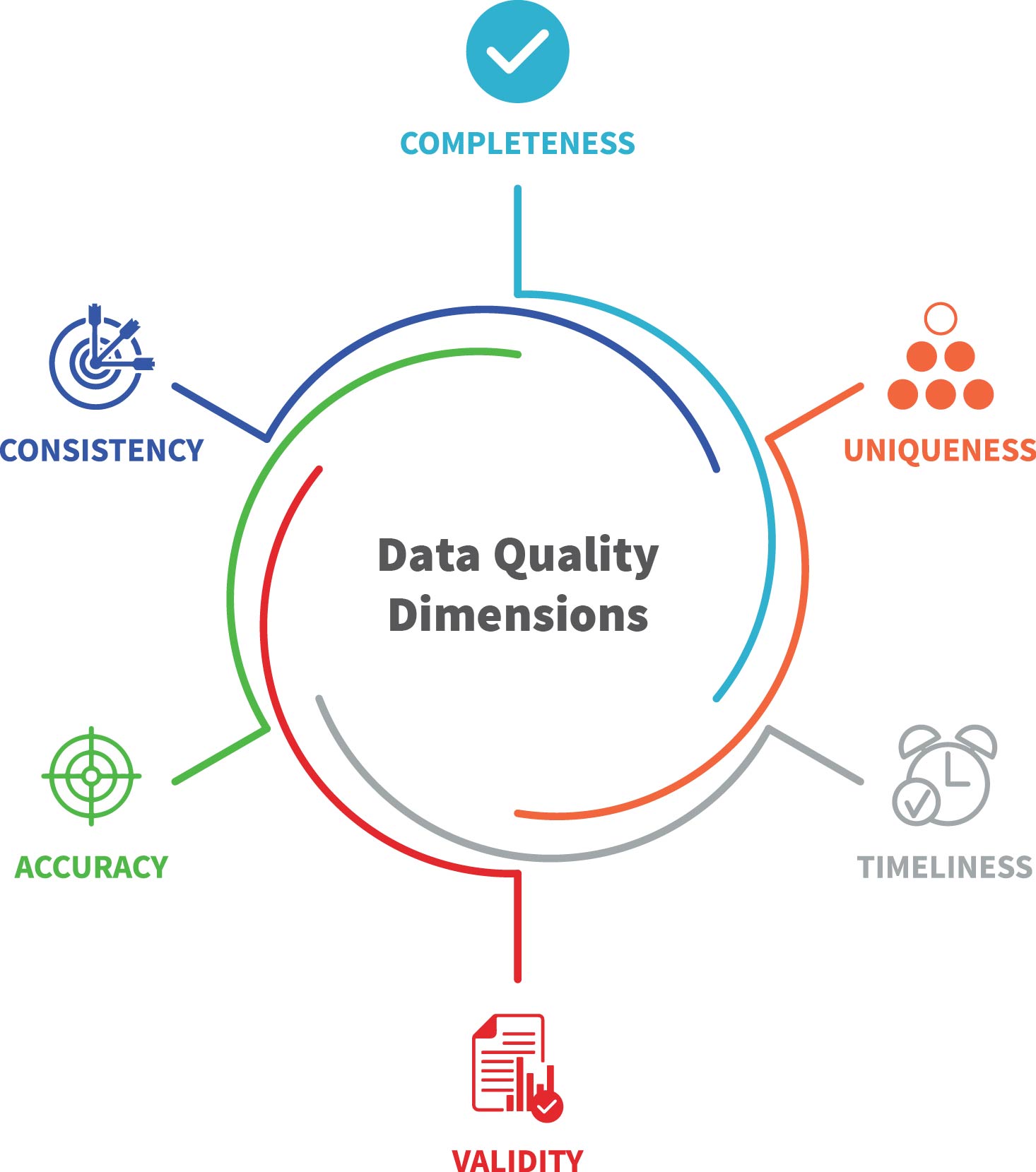¶ Exploring Data Quality
Data quality is a measure of a data set's condition based on factors such as uniqueness, timeliness, accuracy, completeness, consistency and validity.
Assessing data quality enables organizations to detect errors and inconsistencies in their data, ensuring its suitability for intended purposes.
As the significance of data in business operations and advanced analytics becomes increasingly apparent, organizations are prioritizing data quality management. It serves as a fundamental aspect of an organization's broader data governance strategy.
Data governance encompasses the proper storage, management, protection, and consistent utilization of data across an organization, ensuring its integrity and reliability.

¶ Completeness
| Does it fulfill users’ expectations as to how fully it represents the truth? |
Definition: Completeness measures the degree to which all expected or required data is present within a dataset. It ensures that there are no missing values or gaps in the data.
Importance: Data completeness is crucial for making informed decisions and conducting accurate analyses. Incomplete data can lead to biased results, incorrect conclusions, and unreliable insights.
Factors: Completeness can be influenced by various factors, including data collection processes, data entry errors, system failures, and data integration issues.
Metrics: Metrics used to assess data completeness may include the percentage of missing values in a dataset, the presence of required fields, or the comparison of expected data volume to actual data volume.
¶ Uniqueness
| Is this the only instance in which this information appears in the database? |
Definition: Uniqueness refers to the property of data where each record or entity within a dataset is distinct and does not contain any duplicate entries.
Importance: Uniqueness ensures data integrity and accuracy by preventing redundant or duplicate information from skewing analysis results and decision-making processes.
Factors: Factors that may impact data uniqueness include data entry errors, data integration from multiple sources, data processing algorithms, and data storage mechanisms.
Metrics: Metrics used to evaluate data uniqueness may include the count of duplicate records, the presence of unique identifiers, or the identification of primary keys within a dataset.
¶ Timeliness
| Is your information available when users need it? |
Definition: Timeliness refers to the degree to which data is up-to-date and available within an expected timeframe, aligning with business requirements and user needs.
Importance: Timeliness ensures that data is relevant and actionable, enabling informed decision-making and supporting business processes that rely on current information.
Factors: Factors influencing data timeliness include data capture processes, data processing and integration pipelines, data transmission delays, and system performance.
Metrics: Metrics for assessing data timeliness may include data latency measurements, data delivery timelines, adherence to data refresh schedules, and the frequency of data updates.
¶ Validity
| Is information in a specific format, does it follow business rules, or is it in an unusable format? |
Definition: Validity refers to the extent to which data conforms to predefined rules, constraints, and standards, ensuring that it accurately represents the real-world entities or phenomena it is intended to describe.
Importance: Validity ensures the trustworthiness and reliability of data for decision-making and analysis purposes. It ensures that data accurately reflects the intended aspects of the real world and supports meaningful insights and conclusions.
Factors: Factors influencing data validity include data collection methods, data entry processes, data transformation and integration procedures, and data validation mechanisms.
Metrics: Metrics for assessing data validity may include the percentage of data records that meet predefined validation rules, adherence to data format standards, and the accuracy of data values compared to expected ranges or categories.
¶ Accuracy
| How well does a piece of information reflect reality? |
Definition: Accuracy refers to the closeness of data to the true or actual values it represents, reflecting the degree to which data reliably reflects reality without errors or biases.
Importance: Accuracy is crucial for ensuring that data-driven insights and decisions are based on reliable information. It directly impacts the reliability and trustworthiness of analysis results and business outcomes.
Factors: Factors influencing data accuracy include data collection methods, data entry processes, data transformation algorithms, data integration procedures, and data validation mechanisms.
Metrics: Metrics for assessing data accuracy may include measures of data error rates, data discrepancy levels, data validation results, and the consistency of data values across different sources or systems.
¶ Consistency
| Does information stored in one place match relevant data stored elsewhere? |
Definition: Consistency refers to the degree to which data values are uniform and coherent across different sources, systems, and time periods, ensuring that data remains reliable and dependable for analysis and decision-making.
Importance: Consistency ensures that data remains coherent and reliable, supporting accurate analysis, effective decision-making, and reliable business processes. It reduces the risk of errors, discrepancies, and misunderstandings that can arise from inconsistent data.
Factors: Factors influencing data consistency include data integration processes, data transformation workflows, data synchronization mechanisms, and data governance practices.
Metrics: Metrics for assessing data consistency may include measures of data alignment across different datasets or systems, data synchronization rates, data reconciliation results, and the coherence of data values over time.
Data with high integrity has contextual richness, is well-governed, and is integrated across multiple systems so that your organization has a single view of the truth. Data with high integrity must also have high data quality, of course.
In Fast.bi you have the flexibility to employ two distinct approaches for data validation: DBT tests, dbt_utils, dbt_expectation, re-data tests.